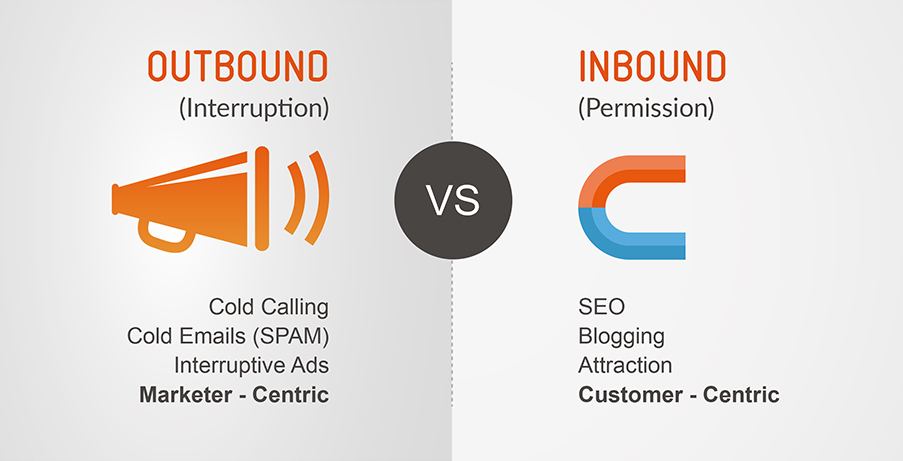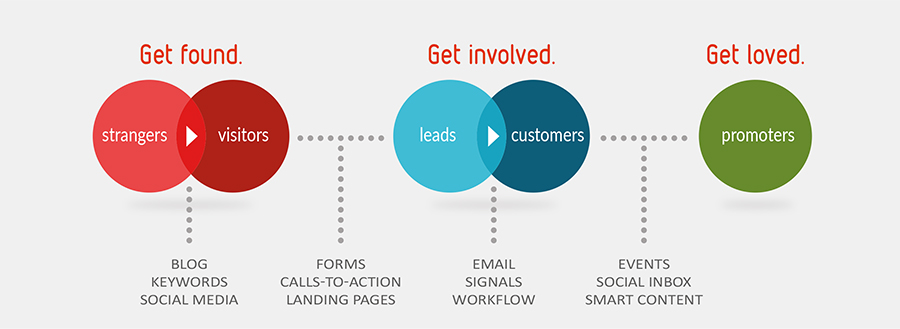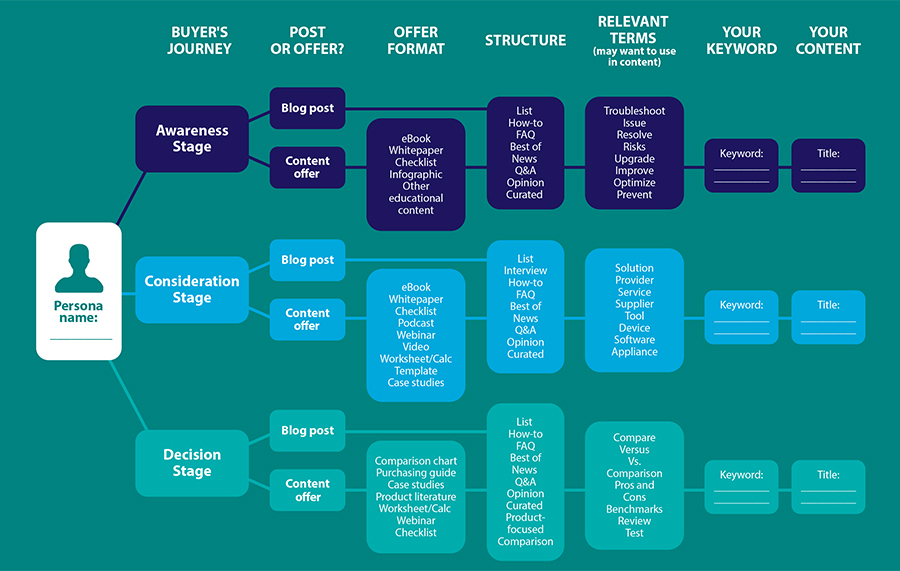Whether you have already deployed inbound marketing or are considering the idea of starting now, these 10 expert tips will help you set and achieve your B2B marketing goals.

1. Master Your Inbound Strategy
As a B2B marketer, you know the drill: every marketing effort should start with a detailed strategy to bring actual results. It’s no surprise then that 76% of B2B marketers admit to adopting inbound marketing as their primary focus. If you haven’t already, it’s time to seriously think about your website, blog, and social media accounts, and how they can bring leads inbound.
The first steps toward an effective inbound marketing strategy are defining your business goals, thoroughly researching your industry, and understanding your customers. Your goals should focus on revenue and the key performance indicators you will observe. You also need to decide what you wish to grow—is it the number of leads, the number of customers, or just the revenue itself?
Once you’ve defined your KPIs, you’re ready to move to the next level: understanding your industry. It’s useful to research how your competitors go about inbound marketing and to catch up on important industry statistics.
Finally, you have to delve into how best to meet your customers’ needs.
2. Focus on Your Target Audiences with Laser Precision

Your customers’ needs deserve special attention. Without a sharp eye on your target audience, it will be difficult for any content marketing to succeed. Consider demographics and top channels for communication, and conduct detailed research of your potential customers’ pain points.
A great way to start is by creating semi-fictional buyer personas. These characters represent groups of target customers, and their needs and rationales for choosing to use (or not use) your products or services. Segmentation is key here. While it’s counterproductive to have too many personas, it’s also important to distinguish different groups within your target audience. This way, you can connect with them on a more personal level.

Once you’ve designed personas on the basis of real-life research, you need to thoroughly map out the buyer’s journey. This way, you can ensure that your messages will target the right people at the right time.
3. Enhance Your Lead Nurturing Efforts
Getting your timing right is crucial when communicating with leads. The purpose of lead nurturing is to make the potential customer sales-ready, so that your sales team can more easily convert them. But it’s easy to make the mistake of sending too many messages to qualifying leads at disorganized times, which might make them think twice about subscribing to your emails.
If your sales cycle is a couple of months, aim to give people a nudge every few weeks. It’s important to make your messages enticing with a careful choice of words adapted to the buyer persona’s characteristics and your communication goals.
Offering leads some kind of reward is also a smart idea—for example, a content asset such as a whitepaper, or an exclusive trial of your services. Either way, make sure that your giveaway is appropriate for how far along in the buyer’s journey the lead is located.
4. Dedicate Resources to Useful and Timely Blogging
Content is at the helm of inbound marketing. Blogging is one of the most widespread channels, and it has proven to be a truly effective way to help businesses achieve their goals. But, in order to stand out in today’s overabundance of information, your blog has to be useful. It should offer innovative solutions to the real problems of your target audiences and inspire them with original ideas.
An important point to remember about content is that quality beats quantity. Valuable, eye-catching information is what will motivate people to follow your company’s blog. Your blog posts also need to be consistent—both with your branding and each other. And no piece of effective content is complete without a call-to-action, giving your readers a clear idea of what to do next.
Sources of inspiration for your content can be found everywhere—from FAQs to customer reviews. You can also refer to successful inbound marketing blogs to catch up on the latest trends and best practices.
5. Don’t Forget About Guest Blogging
Producing rich and high-quality content can be quite resource-demanding. A great way to supplement your work, therefore, is to invite guest bloggers to contribute to your owned media with their own original content.
Guest blogging is a great way to collaborate with great authors, industry experts, and influencers. Along with fresh content, they will also bring their audience to your company. How? When contributors publish a post on your blog, they are likely to promote it via their own channels. This means extra exposure for your website, and also shows that the guest blogger approves of your brand.
Or, consider becoming a guest blogger yourself. This, too, can give your blog additional visibility, as well as backlinks.
6. Use the Power of Premium Content
Want to create content that’s even more impressive?
Go premium.
Premium content can take the form of a whitepaper, ebook, infographic, case study or how-to guide on topics that would interest your audience. These types of assets can boost your online presence, attract more people to your brand, and help to position you as an industry expert.
In this sense, premium content holds great potential for lead generation. While blog posts can be quick and easy to produce, more comprehensive content can offer long-lasting value. Also, different types of content can be applied at various stages of the buying cycle—giving visitors what they want, and converting them into leads, and eventually, long-term customers.
Sharing premium content is also a great way to collect email contacts. Content assets such as guides and whitepapers can be “gated,” meaning that a visitor needs to leave their email in order to download. This is how potential leads commonly become subscribers of your email campaigns.
7. Build Your Email List
Gating premium content is just one of the many ways to compile an email list of qualifying leads.
You might choose another—social media interactions, direct queries, or user comments, for example—but, no matter what, building an email list should be a top priority. Try to see every interaction with a prospect as an opportunity to collect their contact details.
There are a number of other simple but clever ways to grow your email list—for example, adding a subscription link to all your employees’ email signatures or promoting an offer, quiz, or prize on social media.
8. Showcase Customer Reviews and Testimonials
While nurturing leads with original content and email campaigns, it’s important to continue to develop your brand’s presence. Attracting prospects to your owned media is great, but only if they then find sufficient evidence that your company is credible and worth their time.
That’s why showcasing your brand’s credibility should be on your inbound to-do list. One of the most effective ways to do this is to include customer reviews and testimonials on your company website, blog, social media networks, and even YouTube channel.
Instead of churning out promises about your products or services yourself, provide reviews and testimonials as trustworthy accounts of what your prospects can expect when they choose your brand. These authentic opinions about your products and services are often the most persuasive to your future buyers.
9. Embrace Creative Campaigns
Just a gentle reminder: B2B marketing campaigns don’t need to be boring and stiff.
Many B2B marketers still expect that their target audiences won’t appreciate humor or unorthodox approaches and instead use a more formal style in their campaigns.
But when you craft your inbound campaigns, don’t forget that B2B decision makers are people. While they need to make important finance-related decisions, they are also influenced by emotions like the rest of us. Your content should be educational and high-quality—but don’t be afraid to surprise your audience with the way you deliver that information.
In fact, creative messages are more likely to help you reach your campaign goals. Using the right balance of humor, personalization, and storytelling within your content is paramount to your inbound marketing success. B2C campaigns can actually be a great source of inspiration for your B2B marketing efforts.

10. Deliver Interactive and Visual Materials
After you’re comfortable employing the above techniques for written content, it’s time to get visual. Embedding graphics and imagery is a big win, since these types of marketing tactics are processed more easily by our brains. Instead of investing time in a long read, people often prefer to check out an infographic or watch a video.
Try content repurposing—in other words, turning your old whitepapers and guides into brief multimedia assets. These could be interactive presentations or, if you have extra resources, witty and educational videos.
It’s also easier to share visual and interactive content over social media. Content illustrated with relevant images gets viewed 94 percent more, so creating visual content is a top priority for digital marketers.
So now you know inbound marketing doesn’t need to be boring—but it also doesn’t need to be complicated. You can produce impressive results from your B2B marketing efforts even with basic knowledge of its principles. The 10 best practices you’ve seen here have proven their value in past years, so why not experiment with them in your own inbound marketing strategy?
And the most important thing to remember: Focus on your target audiences and their most pressing challenges, so that your content provides a solution. Start with a thorough plan, craft useful and timely content, and nail down your customers’ buying cycles. That’s how you’ll be able to offer them what they need, when they need it—a surefire way to turn your leads into buyers.

